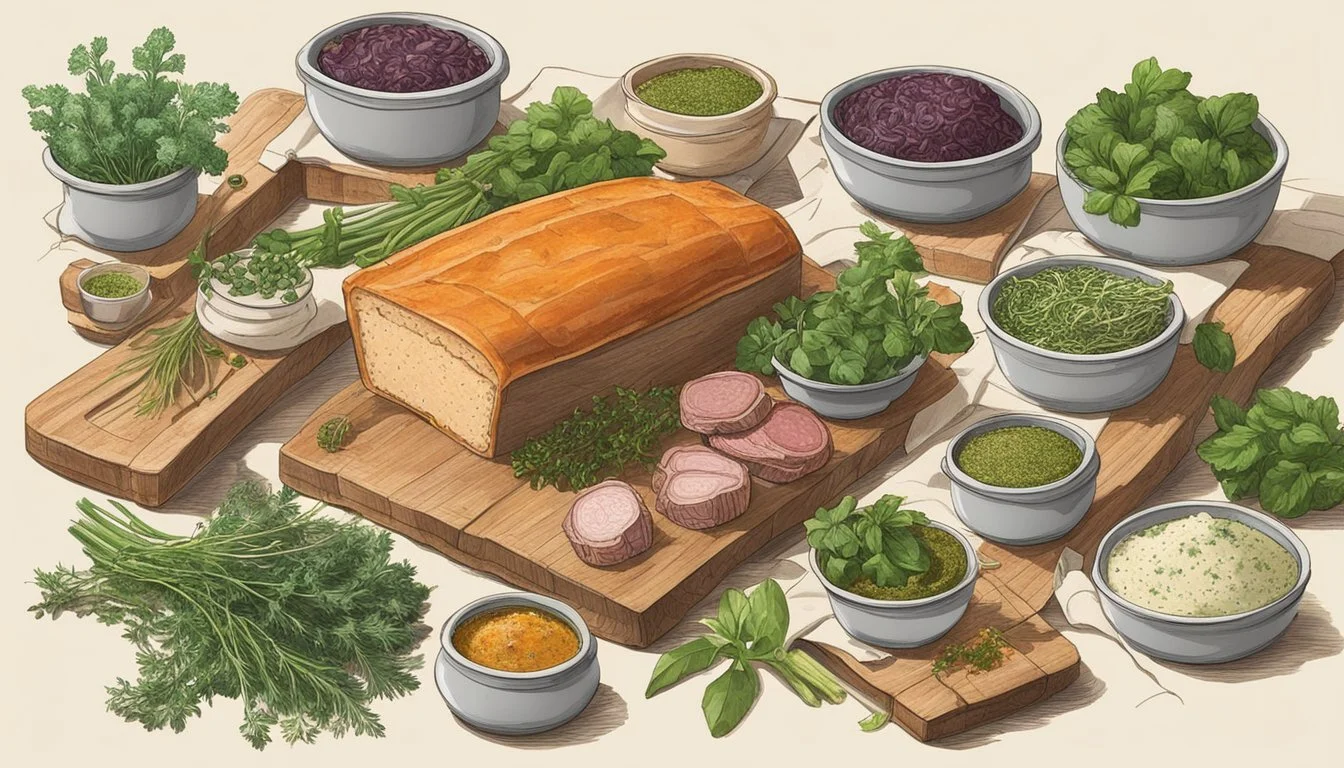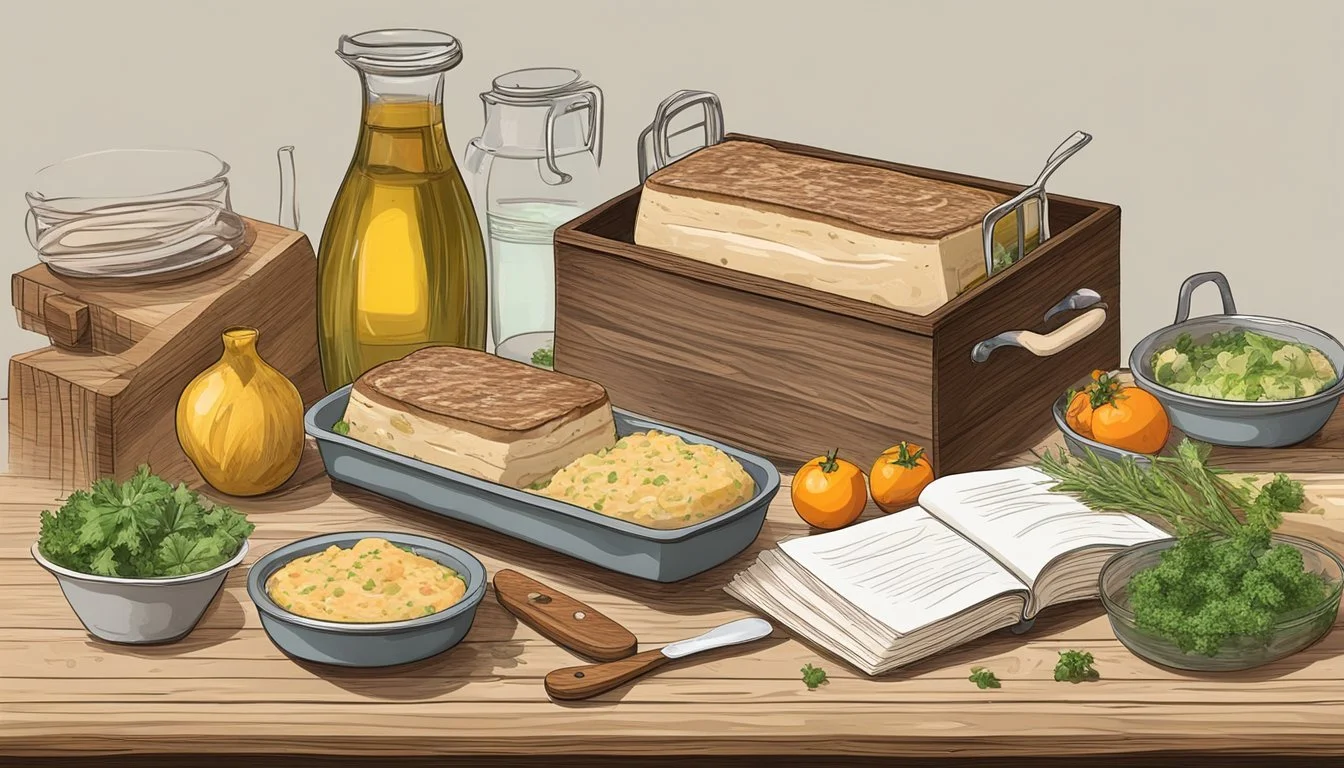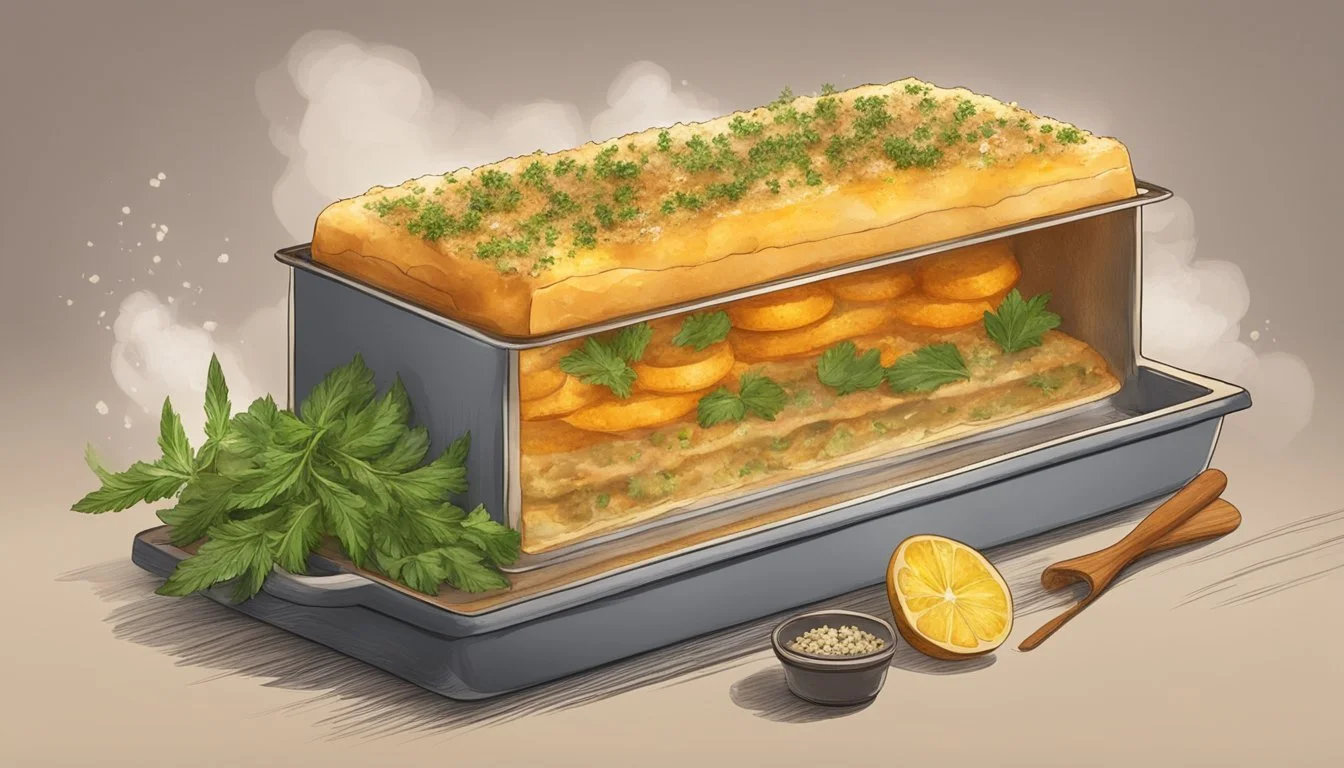Homemade Terrine 101
Your Step-by-Step Guide to Mastering Classic French Terrines
A terrine is a delightful addition to any gourmet table, showcasing the art of fine charcuterie (What wine goes well with charcuterie?) with rich and intricate flavors. This classic French dish is molded and often made with a mixture of ground meats, herbs, and seasonings, packed into a loaf pan and cooked in a water bath to create a dense, sliceable texture. Perfect for serving as an appetizer or part of a charcuterie board, homemade terrines can be custom-made to suit various palates, incorporating game, poultry, seafood, or even purely vegetarian ingredients.
Creating a terrine at home begins with selecting quality ingredients and understanding the layering process that contributes to its complex taste profile. When making a terrine, attention to detail is key, such as gently sautéing aromatics to prevent browning and meticulously avoiding air pockets during assembly. Despite appearing intricate and sophisticated, the preparation of a terrine can be quite straightforward, and beginners can achieve remarkable results by following a few key steps.
The terrine's versatility is evident in the way it can be adapted to accommodate different tastes and occasions. Once cooked and cooled, it can be served with various accompaniments, from simple toast points or crusty bread to pickles and mustards. It's not only a testament to culinary prowess but also a testament to the time-honored traditions of terrine-making, where patience and precision yield a dish that is at once rustic and refined.
History and Types of Terrine
The art of terrine preparation has its roots deeply set in French cuisine, a testament to France's rich gastronomic history. The term "terrine" derives from the French word "terre," referring to the earthenware container typically used to make the dish. Historically, terrines are a method to preserve meats before the advent of refrigeration. Today, the terrine is prized both for its practicality and its presence on gourmet menus.
Terrine de Campagne, often referred to as country terrine, is a traditional type that includes a coarse mixture of pork and other meats, with the addition of herbs and spices for a rustic appeal. It can also feature poultry or game, showcasing the versatility of the dish across different regions in France. Each variety delivers a unique taste experience influenced by the local ingredients and methods.
Another renowned type is Foie Gras Terrine, a more luxurious variant known for its rich, smooth texture and intricate flavors. This type is crafted from the liver of duck or goose and is a delicacy enjoyed by gourmands around the world.
Terrines may come in a myriad of forms, from simple meat-based recipes to elaborate layers of seafood or vegetables. They can be served cold or at room temperature, often sliced and accompanied by bread or as part of a charcuterie board.
Common Types of Terrine Primary Ingredient Terrine de Campagne Pork, game, poultry Foie Gras Terrine Duck or goose liver Seafood Terrine Various seafood Vegetable Terrine Seasonal vegetables
The craft of making terrines is a fine balance between technique and creativity, allowing chefs to leave their mark on this classic dish through personal interpretations and innovative ingredient combinations.
Essential Ingredients
Creating a homemade terrine requires a well-considered selection of ingredients. The right combination of meat, herbs, spices, and additional components is critical for achieving the desired flavor and texture.
Meat Selection
A terrine's foundation is its meat, which can range from pork, chicken, veal, to game meats. The use of liver—such as pork fat, chicken livers, or ham—is common to add richness. For a classic texture, beginners might opt for a mixture of ground pork and veal, while those seeking variety may include bacon or game meats.
Herbs and Spices
Herbs and spices are essential for imparting character and depth to the terrine. Core herbs include thyme, parsley, and bay leaves, while spices such as cloves, black pepper, nutmeg, ginger, and allspice add complexity. They must be used with precision:
Thyme: 2 teaspoons finely chopped
Parsley: 1/4 cup finely chopped
Bay leaves: 2 leaves placed atop before cooking
Spices (each): 1/4 teaspoon (or to taste)
Additional Components
Terrines often incorporate other components to enhance their flavor and texture:
Eggs and bread are binding agents that help in forming the terrine’s shape.
Nuts like pistachios or hazelnuts introduce a pleasant crunch.
Vegetables—like garlic, onions, or shallots—are sautéed and mixed into the base for aromatic sweetness.
Brandy or cognac: a splash can be included for an added depth of flavor, balancing the richness of the meats.
It's best to prepare all ingredients before assembling to streamline the process.
Necessary Equipment
To craft a terrine at home, one requires specific equipment to ensure proper formation and cooking. Getting familiar with the essential tools can make the terrine-making process smooth and efficient.
Terrine Mold Choices
A terrine mold is the central piece of equipment; it is typically rectangular, with straight sides and a tight-fitting lid. Ideal materials for a terrine mold include:
Wood: Traditional but less common, wooden molds impart a unique flavor and are best for non-baked terrines.
Metal: Ideal for heat conduction; often used for baked terrines. Some metal molds come with a press to compact the layers.
Ceramic: Ceramic molds provide excellent heat retention suitable for slow cooking.
Earthenware or Stoneware: Durable and retains heat well, similar to ceramic molds.
Alternatively, a standard loaf pan serves as a practical substitute if a specialized terrine mold is not available. Lining the chosen mold with cling film or baking parchment can facilitate easy removal, while a double layer of foil is useful if a lid is not present to cover the terrine during cooking.
Kitchen Tools
Below are the essential kitchen tools needed:
Sharp Knife: A necessity for precise cutting and preparation of ingredients.
Cling Film: Used to line the mold for easier terrine removal.
Oven: Required for baking the terrine, typically at moderated temperatures around 350°F (177°C).
Fridge: Crucial for chilling the terrine and allowing the flavors to meld post-cooking.
Press: A terrine press or a makeshift one (such as a weighty object) helps in compacting the terrine while it sets in the fridge.
Optional (for water bath):
A larger pan to hold water for a water bath during baking, promoting even cooking and preventing drying out.
Note: The equipment should be prepared and ready to use before beginning the terrine-making process.
Preparation Techniques
In terrine preparation, precision in chopping, methodical assembling, and careful cooking are vital to ensure a flavorful and well-structured result.
Chopping and Grinding
A sharp knife is essential for finely chopping herbs and creating a smooth, homogeneous forcemeat. Ground pork is a common base for many terrine recipes, providing a rich flavor and ideal texture. It's typically ground twice for fineness. Forcemeat preparation also involves mixing in elements like pistachios and seasoning herbs, creating layers of flavor within the terrine.
Chopping Herbs:
Herbs Chop Technique Thyme Finely Parsley Coarsely
Meat Type Grind Type Pork Fine, twice
Layering and Assembling
Terrine assembly starts with lining the mold. Many chefs use cling film or bacon to prevent sticking, and layering begins with the forcemeat—alternating with additional ingredients like pistachios for texture contrast. To avoid air pockets, pressing down each layer and tapping the mold on a solid surface is advised.
Lining Terrine Mold:
Lining Material Method Cling film Cover mold interior Bacon Overlapped layers
Layering Ingredients:
Layer Ingredient Technique 1 Forcemeat Spread evenly 2 Bacon Layer over forcemeat 3 Pistachio Sprinkle evenly
Cooking Methods
Cooking a terrine correctly affects texture and flavor profoundly. The terrine is baked in a water bath, or 'bain-marie,' at a moderate temperature. This ensures even, gentle cooking that retains moisture. A vital step is to monitor the terrine's internal temperature, aiming for an internal temperature around 160°F (71°C) for perfect doneness.
Baking in Water Bath:
Step Action 1 Preheat oven 2 Fill bain-marie 3 Place terrine in bain-marie
Temperature Monitoring:
Metric Details Internal Temperature 160°F (71°C) Oven Temperature 350°F (177°C)
Seasoning and Flavoring
Seasoning is a critical step in preparing a terrine, as it contributes significantly to the flavor profile of the final dish. Salt and pepper are foundational to terrine seasoning, with salt enhancing the natural flavors and pepper adding a subtle heat and complexity.
When incorporating garlic, one should finely mince or press it to distribute its robust flavor evenly throughout the terrine. Garlic not only adds depth but also complements the rich, meaty flavors commonly found in terrine recipes.
Terrines benefit greatly from the addition of herbs. Fresh herbs such as thyme, parsley, and rosemary bring bright, aromatic qualities to the dish, while dried herbs offer more concentrated flavors. For an optimal experience, one should consider the balance between fresh and dried herbs:
Fresh Herbs: Add a light, refreshing taste.
Dried Herbs: Provide a more potent, earthy essence.
Spices play an essential role as well, and the selection should align with the overall flavor theme of the terrine:
Smoked paprika can impart a gentle smokiness.
Nutmeg offers a warm, nutty undertone.
The secret to a well-seasoned terrine lies in the subtlety and balance of flavours. Less is often more; a terrine should maintain a harmonious blend without any one seasoning overpowering the others. Chefs must taste and adjust the seasonings carefully, ensuring every ingredient complements the others, producing a cohesive and delightful palate experience.
Curing and Preservation
Curing is the essential first step in making a terrine, as it ensures both preservation and flavor enhancement of the meat. The primary agent in this process is salt, which acts to inhibit bacterial growth by drawing out moisture.
For beginners, there are two common methods of curing:
Dry Curing: The meat is rubbed with a mixture of salt, and optionally sugar and spices, then left in a fridge to cure. A rule of thumb is to cure the meat for a day per pound. The process is complete when the meat has firmed up.
Wet Curing (Brining): The meat is submerged in a solution of water, salt, and additional flavorings. This method is often preferred for its ability to cure more evenly and retain moisture.
Following the curing stage, aspic is sometimes used to encase the layered terrine. Aspic is a savory jelly made from stock that has been boiled to release gelatin from the bones, or from gelatin powder. This gel layer not only adds a decorative glaze but also provides an additional protective layer, aiding in the preservation of the terrine.
Terrine enthusiasts usually use a chilled setting such as a refrigerator during the curing and setting of the aspic to ensure proper consistency and preservation. The refrigerator's cool temperature slows down bacterial activity and sets the gelatin firmly. Here's a quick guide on aspic preparation:
Prepare the stock and bring it to a boil or dissolve gelatin in water as per instructions.
Pour the liquid aspic over the terrine before it sets, usually after the terrine has been cooked and cooled.
Refrigerate the terrine until the aspic is firm and clear.
One should always ensure the meat is properly cured and the aspic is well set to guarantee the terrine is safely preserved and presents well when sliced.
Serving the Terrine
Serving a homemade terrine successfully involves presenting it in a way that highlights its firm texture and rich flavor. Attention to detail in the presentation and choice of accompaniments can elevate the overall experience.
Presentation
A terrine, once unmolded, should present a clean, firm shape that can be sliced with ease. Use a sharp knife to cut the terrine, wiping the blade between slices to ensure clean cuts. Serve individual slices on plates or arrange them attractively on a platter.
Platter Suggestion:
Arrange on a wooden cutting board or a ceramic dish
Slice Thickness: Approximately 1/2 inch thick
Presentation is key to enticing the appetite, and careful slicing will showcase the cohesive texture, embedded ingredients, and the craft involved in making the pâté.
Accompaniments
Proper accompaniments not only complement the flavors of the terrine but also provide a variety of textures.
Bread and Crackers: Offer a selection of sliced bread, such as a baguette, and a variety of crackers for spreading or topping with terrine.
Condiments: Include small bowls of Dijon mustard, chutneys, or pickles like cornichons to enhance the richness with acidity and spice.
Garnishes: Sprinkle minced chives over the terrine for a fresh, herbaceous note.
Salad: Serve a simple salad alongside to balance the density and nutrition of the terrine with a lighter element.
Cheese: A choice of mild or sharp cheese can either contrast or complement the terrine's flavor profile.
In choosing accompaniments, one should consider the strength and character of the terrine's flavor to select the best pairing that will enhance and not overshadow the main dish.
Storage and Safety
When storing homemade terrine, refrigeration is essential. Freshly prepared terrine should be wrapped in cling film and placed in the fridge to cool and set properly. It's crucial to ensure that the terrine is covered tightly to prevent it from absorbing odors from other foods in the fridge. Typically, terrine can be stored in the refrigerator for up to three to five days.
Temperature: Always keep terrine below 5°C (41°F) to prevent the growth of harmful bacteria. If the terrine is not consumed within this time frame, one should consider freezing it for longer preservation.
Freezing: If the terrine is meant for long-term storage, it should be wrapped in cling film and then aluminum foil to avoid freezer burn.
Thawing: Thaw frozen terrine in the refrigerator overnight to maintain its texture and integrity.
When it comes to nutrition, terrine made with high-quality, fresh ingredients can offer nutritional value. However, its content of fats and proteins makes it a dish that should ideally be consumed in moderation within a balanced diet.
Nutrition Labeling: If preparing terrine for wider distribution, clear nutritional labeling is necessary. It provides vital information for those with dietary restrictions or allergies.
Lastly, maintaining high standards of safety and cleanliness during preparation cannot be overstressed. Utensils, surfaces, and hands should be properly sanitized to avoid food contamination. Safe handling ensures that the terrine not only tastes good but also safeguards the health of those who consume it.
Troubleshooting Common Issues
When making homemade terrine, cooks may encounter a few common issues that can affect the final product. Understanding these issues and their solutions ensures a terrine that is both aesthetically pleasing and delicious.
Issue: Terrine is too soft or lacks firm texture.
Solution: Ensure the mixture is properly chilled before cooking and that it is cooked long enough to set. If necessary, increase the amount of binding ingredients, such as eggs.
Issue: The terrine is crumbly and doesn't hold together.
Solution: This often results from under-mixing the ingredients or not cooking the terrine at a consistent temperature. A water bath in the oven can help maintain even cooking.
Problem Possible Cause Solution Poor Texture Insufficient chilling Allow longer chilling time before slicing. Mold Separation Greasing issues If using plastic wrap, ensure it's well-greased. For a non-stick surface, consider lining with bacon. Uneven Cooking Oven temperature fluctuations Use an oven thermometer to check for accuracy and adjust accordingly.
For issues related to mold, a baker should check that they’ve correctly lined their terrine mold and that the oven is preheated to a consistent temperature. The terrine should be placed in the center of the oven to ensure even heat distribution. Lastly, firm, even pressure should be applied when pressing the mixture into the mold to eliminate air pockets and achieve a compact, smooth terrine.
Should a terrine lack a firm texture upon completion, a cook may consider chilling the terrine for an extended period before serving, as this allows the terrine to set further and develop the desired firm texture.
Advanced Tips and Variations
When one becomes proficient with the fundamental principles of terrine making, they can explore various advanced techniques and ingredients to elevate their creation.
Incorporating Foie Gras: Foie gras adds a luxurious element to terrines. For a decadent twist, one may layer slices of foie gras in the middle of the terrine before baking. This provides a rich and buttery contrast against the more savory components.
Utilizing Pancetta: For added flavor and texture, experienced cooks often line their terrine mold with pancetta. It not only imparts a smoky taste but also results in an attractive wrapper once the terrine is sliced.
Mastering Spices: The use of spices should be approached with precision. A balance of flavors can be achieved by adding a conservative amount of spices like nutmeg, thyme, or allspice. They recommend a testing phase with small batches to find the perfect spice mix that complements the main ingredients without overwhelming them.
To introduce variety, cooks can explore these variations:
Ingredient Suggestion Purpose Dried Fruit Mix in apricots or cranberries Enhances sweetness & texture Nuts Add pistachios or almonds Introduces a crunchy element Liquor Incorporate cognac or armagnac Adds depth and aromatic warmth
The cook should remain mindful of the harmony between the flavors and textures to ensure a cohesive and enjoyable experience. Careful attention to detail will result in a terrine that is both visually impressive and delectable.







